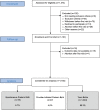Clinical and epidemiological factors associated with spontaneous preterm birth: a multicentre cohort of low risk nulliparous women
- PMID: 31965004
- PMCID: PMC6972868
- DOI: 10.1038/s41598-020-57810-4
Clinical and epidemiological factors associated with spontaneous preterm birth: a multicentre cohort of low risk nulliparous women
Abstract
The objective of this study was to determine incidence and risk factors associated with spontaneous preterm birth (sPTB). It was a prospective multicentre cohort study performed in five Brazilian referral maternity hospitals and enrolling nulliparous women at 19-21 weeks. Comprehensive maternal data collected during three study visits were addressed as potentially associated factors for sPTB. Bivariate and multivariate analysis estimated risk ratios. The main outcomes measures were birth before 37 weeks due to spontaneous preterm labour or premature rupture of membranes (sPTB). The comparison group was comprised of women with term births (≥37weeks). Outcome data was available for 1,165 women, 6.7% of whom had sPTB, 16% had consumed alcohol and 5% had used other illicit drugs during the first half of pregnancy. Current drinking at 19-21 weeks (RR 3.96 95% CI [1.04-15.05]) and a short cervix from 18-24 weeks (RR 4.52 95% CI [1.08-19.01]) correlated with sPTB on bivariate analysis. Increased incidence of sPTB occurred in underweight women gaining weight below quartile 1 (14.8%), obese women gaining weight above quartile 3 (14.3%), women with a short cervix (<25 mm) at 18-24 weeks (31.2%) and those with a short cervix and vaginal bleeding in the first half of pregnancy (40%). Cervical length (RRadj 4.52 95% CI [1.08-19.01]) was independently associated with sPTB. In conclusion, the incidence of sPTB increased in some maternal phenotypes, representing potential groups of interest, the focus of preventive strategies. Similarly, nulliparous women with a short cervix in the second trimester require further exploration.
Conflict of interest statement
The authors declare no competing interests.
Figures
References
Publication types
MeSH terms
LinkOut - more resources
Full Text Sources


